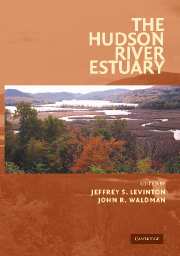Book contents
- Frontmatter
- Contents
- Preface
- List of Contributors
- The Hudson River Estuary
- 1 The Hudson River Estuary: Executive Summary
- GEOLOGICAL, PHYSICAL, AND CHEMICAL SETTING OF THE HUDSON
- PRIMARY PRODUCTION, MICROBIAL DYNAMICS, AND NUTRIENT DYNAMICS OF THE HUDSON
- HUDSON RIVER COMMUNITIES, FOOD WEBS, AND FISHERIES
- CONTAMINANTS AND MANAGEMENT ISSUES OF THE HUDSON RIVER ESTUARY
- 22 The History and Science of Managing the Hudson River
- 23 Hudson River Sewage Inputs and Impacts: Past and Present
- 24 PCBs in the Upper and Tidal Freshwater Hudson River Estuary: The Science behind the Dredging Controversy
- 25 Transport, Fate, and Bioaccumulation of PCBs in the Lower Hudson River
- 26 Contaminant Chronologies from Hudson River Sedimentary Records
- 27 Atmospheric Deposition of PCBs and PAHs to the New York/New Jersey Harbor Estuary
- 28 Toxic Substances and Their Impact on Human Health in the Hudson River Watershed
- 29 Impacts of Piers on Juvenile Fishes in the Lower Hudson River
- 30 Physiological and Genetic Aspects of Toxicity in Hudson River Species
- Index
- Plate section
- References
23 - Hudson River Sewage Inputs and Impacts: Past and Present
Published online by Cambridge University Press: 06 January 2010
- Frontmatter
- Contents
- Preface
- List of Contributors
- The Hudson River Estuary
- 1 The Hudson River Estuary: Executive Summary
- GEOLOGICAL, PHYSICAL, AND CHEMICAL SETTING OF THE HUDSON
- PRIMARY PRODUCTION, MICROBIAL DYNAMICS, AND NUTRIENT DYNAMICS OF THE HUDSON
- HUDSON RIVER COMMUNITIES, FOOD WEBS, AND FISHERIES
- CONTAMINANTS AND MANAGEMENT ISSUES OF THE HUDSON RIVER ESTUARY
- 22 The History and Science of Managing the Hudson River
- 23 Hudson River Sewage Inputs and Impacts: Past and Present
- 24 PCBs in the Upper and Tidal Freshwater Hudson River Estuary: The Science behind the Dredging Controversy
- 25 Transport, Fate, and Bioaccumulation of PCBs in the Lower Hudson River
- 26 Contaminant Chronologies from Hudson River Sedimentary Records
- 27 Atmospheric Deposition of PCBs and PAHs to the New York/New Jersey Harbor Estuary
- 28 Toxic Substances and Their Impact on Human Health in the Hudson River Watershed
- 29 Impacts of Piers on Juvenile Fishes in the Lower Hudson River
- 30 Physiological and Genetic Aspects of Toxicity in Hudson River Species
- Index
- Plate section
- References
Summary
abstract The quality of the Hudson River estuary has been negatively impacted for many years by the discharge of untreated sewage. The abatement of these discharges due to construction and upgrading of wastewater treatment plants (WTP) in the Hudson valley from the 1930s to the 1990s has significantly reduced loadings of suspended solids, oxygen demanding organics, floatables, and pathogens, with lesser reductions observed for nitrogen and phosphorus. In response, water quality conditions have improved significantly. Dissolved oxygen has increased from critically low levels to summer averages that exceed 5 mg l−1 and pollution sensitive insects and marine borers have returned to the estuary. Sanitary quality has also improved with most of the Hudson today considered to meet swimmable water quality standards. Consequently, shellfish beds and bathing beaches have been reopened in New York/New Jersey Harbor and additional beaches are being considered throughout the river. Priorities for the future include: increased capital and operations and maintenance investments for WTPs, improved capture and treatment of combined sewer overflows (CSO), and investigation of the need for nutrient removal.
Introduction
The Hudson River south of the Federal dam at Troy comprises an approximately 240 km long estuarine system that has been subjected to an enormous loading of pollutants from a variety of sources for over three hundred years. Until relatively recently, this loading included the discharge of millions of liters of untreated sewage per day.
- Type
- Chapter
- Information
- The Hudson River Estuary , pp. 335 - 348Publisher: Cambridge University PressPrint publication year: 2006
References
- 8
- Cited by



